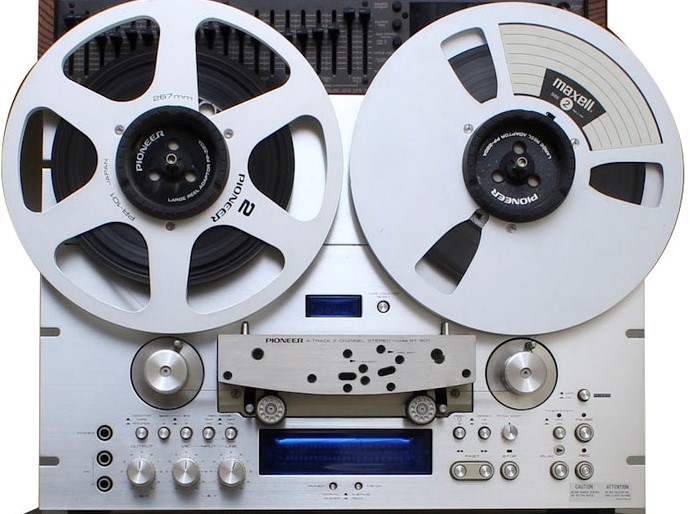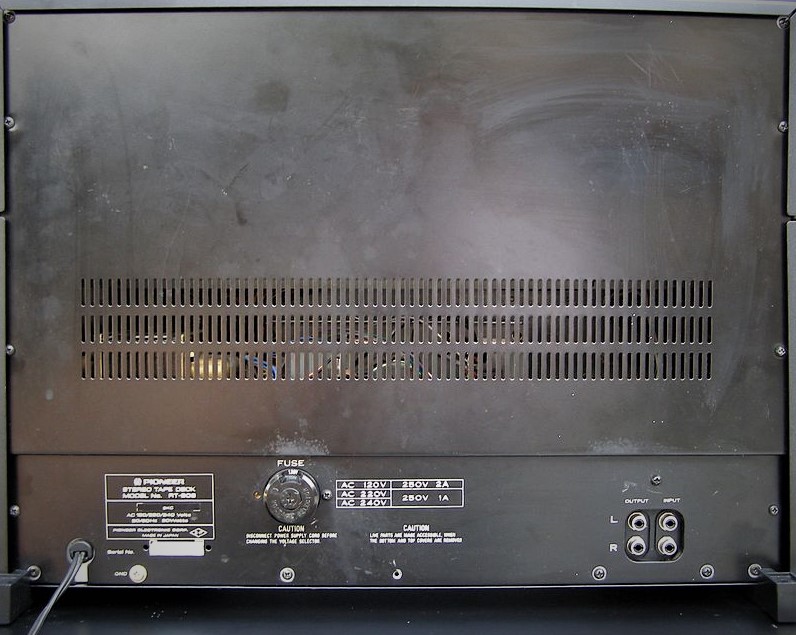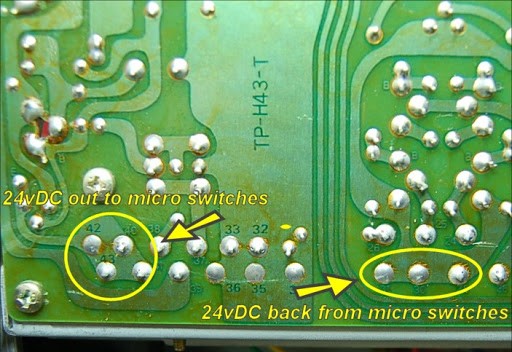Technical Details
Brand: Pioneer
Model:RT-901
Category:Super High Fidelity
Application:Consumer
Electronics:Solid State
Equalization:NAB
Country of Manufacture:Japan
Tracks:1/4 Rec/PB
Speeds: 3 3/4, 7 1/2
Max Reel Size("): 10.5"
Number of heads: 3
Dimension: 19 X 13½ X 12½ " (480 X 340 X 318 Mm)
Head Composition: Permalloy
Head Configuration: Stereo
# Motors: 3
Auto Reverse?:No
Voltage(s): 110-120v, 220-240v
Outputs: RCA
Frequency Response:7½ Ips: 20Hz To 28kHz - 3¾ Ips: 20Hz To 18kHz +-3dB)
Wow and Flutter:.04% @ 7½ Ips - 08% @ 3¾ Ips
Signal-to-Noise Ratio: 60dB @ 7½ Ips - 55dB @ 3¾ Ips
Sound quality rating:8 / 10
Long-term reliability rating: 8/ 10
Weight: 47lbs (21.5kg)
Additional Details
Description
The RT-901 was produced from 1979 until 1984 , with 3 heads and a closed-loop dual capstan drive system that isolated the tape at the heads from any external interference, resulting in a constant tape-to-head contact. Rack-mountable and designed to take 10½ ”reels, Pioneer also produced an auto reverse model, the RT-909.
The combination of ultramodern appearance and very decent sound quality combined to make the RT-909 a winner for pioneer
and to a lesser degree, the 901 which was not that much less expensive than the 909. Relative to similar Teac or Akai models, the 901 has a very deep rich bass sound quality.
Independent microphone and line mixing inputs
Azimuth adjustments for the heads
Fluroscan meter
4 digit tape counter
Timer start switch
Additional Info
Here’s a very decent Service Summary that seems to be widely circulated on the Internet. We have included some part numbers and sources to make it more useful.
– Perform a complete initial functional test, to determine if there are any repair operations need to be performed before restoration, and to provide a baseline for comparison with post-restoration performance.
– Replace both pinch rollers (for some reason, all RT-909 original pinch rollers are gooey/gummy at this age), and adjust the pinch roller pressure. Rollers are still available from Pioneer at a reasonable cost. Oaktreevintage.com
Terry’s rollers – pinch roller rebuild $75.00 for 2
Vintage Electronics – $64.00 for 2 pinch rollers
The Pioneer part number is ?
Replace the capstan drive belt, also still available from Pioneer. Here’s an alternative source for the Capstan Flywheel Belt FBL14.5
Replace the felt brake pads (felt brake pads that are almost 30 years old probably have dried out adhesive, and may appear to work, but we are shooting for another 20-30 years of use here).
Rebuild the tension rollers (they all need to be cleaned, lubed, and fresh damping fluid added)
– Replace the tape sensor micro-switches (they all are somewhat corroded at this age) DigiKey SW765-ND Omron Electronics Inc SS-3GL13P $2 (see last photo on this post)
Micro-switch Notes- In short order, I did verify 24VDC coming off the power supply board pin 43 (green wire) that goes to the left micro switch. The voltage looked good going to the right micro switch (white wire), but as soon as the right switch closes, it dropped the voltage to 2 volts, that goes back to the power supply board pin 29 (yellow wire).
Yes, the micro switches are bad. They couldn’t pass the voltage once any current was needed. I verified this by just jumping from pin 43 to 29 with a clip lead.
Completely disassemble, clean, lube and adjust the transport mechanism (a real contributing operation to sonic performance, like wow and flutter).
Adjust reel torques (braking, take-up, back, FF and REW).
Clean and deoxidize all user controls and internal switches/contacts (most units have dirty controls).
Relap the heads (an absolute necessity if you are going to change how the heads are aligned at all, since they normally have significant wear grooves in them).
Rotate all tape guides (necessary, since they also develop wear grooves from the tape passing over them)
Replace all electrolytic capacitors (they have only a 20-30 year lifespan)
Refresh all circuit board solder joints (flow-soldered joints also have only about a 30 year lifespan)
Verify the power supply voltages and filtering.
Perform a complete REC/PLAY alignment/calibration (head alignments, bias, equalization, levels, meter indications, etc.), optimizing performance for the owner/customer’s blank tape selection (necessary for best performance).
Extended functional testing (over several days), to determine the effects of the restoration, and to ensure that nothing was missed, or damaged.
Perform a complete cosmetic detailing (there are a couple of tricks and gotchas, even for this operation).
The Pioneer RT-909 has 8 circuit boards, with 121 caps, and the parts cost for the caps alone is approximately $65.00. The labor for the complete restoration, for a good tech, will likely be 30 to 40 hours.
Rewind speed approx. 120 seconds (10½ reel 720m tape)
Stereo separation: more than 50dB / Crosstalk: more than 50dB / Distortion: no more than 1% at 7½ ips / Bias frequency: 125kHz / Erase ratio: more than 60dB / Semi-conductors: 4 Fets. 43 ICs. 121 transistors. 125 diodes. 2 photo interrupters / Inputs (sensitivity / maximum / impedance): mic x 2: 0.316mV / 80mV / 27K ohms, 6mm phono jacks line x 2: 50mV / 25V / 50K ohms / Outputs (ref.level / max / imp): line x 2: 450mV / 900mV / 2.6K ohms headphones: 50Mv / 100mV / 8 – 250 ohms






